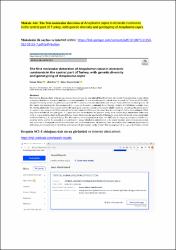| dc.contributor.author | Altay, Kursat | |
| dc.contributor.author | Erol, Ufuk | |
| dc.contributor.author | Sahin, Omer Faruk | |
| dc.date.accessioned | 2023-04-04T12:39:55Z | |
| dc.date.available | 2023-04-04T12:39:55Z | |
| dc.date.issued | 2022 | tr |
| dc.identifier.citation | Altay, K*., Erol, U., & Sahin, O. F. (2022). The first molecular detection of Anaplasma capra in domestic ruminants in the central part of Turkey, with genetic diversity and genotyping of Anaplasma capra. Tropical Animal Health and Production, 54(2), 129. https://doi.org/10.1007/s11250-022-03125-7 | tr |
| dc.identifier.uri | https://link.springer.com/content/pdf/10.1007/s11250-022-03125-7.pdf | |
| dc.identifier.uri | https://hdl.handle.net/20.500.12418/13317 | |
| dc.description.abstract | Tick-borne diseases have been an increasing threat to human and animal health all over the world. Anaplasmosis is one of the
emerging tick-borne diseases and has zoonotic potential. A new novel species, which was detected in China in 2010–2012
and provisionally named Anaplasma capra in 2015, causes zoonotic infections and infects many diferent animal species. In
this study, we investigated the presence of A. capra in domestic ruminants from Turkey. A total of 468 blood samples (cattle, sheep, and goat) were examined by the gltA gene-specifc nested polymerase chain reaction, revealing the presence of
A. capra in six samples (1.28%): one of them from cattle (0.41%) and the other fve from sheep (3.22%). According to DNA
sequences results of the gltA gene, A. capra isolates identifed in the present study were shown high nucleotide similarity
with A. capra isolates detected from diferent hosts. However, the nucleotide diferences were detected in the same nucleotide
positions between A. capra isolates. For this reason, we thought that at least two diferent A. capra genotypes could be circulating in the world. As a result, it is seen that A. capra, which was determined to be a new species with zoonotic potential,
was revealed in European and Asian countries and in diferent hosts. In order to raise awareness about human anaplasmosis
infections, it is important to reveal the prevalence of the species in the world. The emergence of A. capra in Turkey reveals
the need for a re-evaluation of the human and animal health risk analysis in terms of anaplasmosis. | tr |
| dc.language.iso | eng | tr |
| dc.relation.isversionof | https://doi.org/10.1007/s11250-022-03125-7 | tr |
| dc.rights | info:eu-repo/semantics/restrictedAccess | tr |
| dc.subject | Anaplasma capra, Cattle, Sheep, gltA, Turkey | tr |
| dc.title | The first molecular detection of Anaplasma capra in domestic ruminants in the central part of Turkey, with genetic diversity and genotyping of Anaplasma capra | tr |
| dc.type | article | tr |
| dc.relation.journal | Tropical Animal Health and Production | tr |
| dc.contributor.department | Veteriner Fakültesi | tr |
| dc.contributor.authorID | https://orcid.org/0000-0002-5288-1239 | tr |
| dc.identifier.volume | 54 | tr |
| dc.identifier.issue | 2 | tr |
| dc.identifier.startpage | 129 | tr |
| dc.relation.publicationcategory | Uluslararası Editör Denetimli Dergide Makale | tr |















